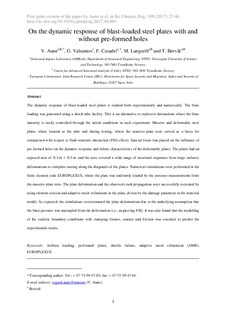| dc.contributor.author | Aune, Vegard | |
| dc.contributor.author | Valsamos, Georgios | |
| dc.contributor.author | Casadei, Folco | |
| dc.contributor.author | Langseth, Magnus | |
| dc.contributor.author | Børvik, Tore | |
| dc.date.accessioned | 2017-10-18T13:18:28Z | |
| dc.date.available | 2017-10-18T13:18:28Z | |
| dc.date.created | 2017-08-08T09:45:42Z | |
| dc.date.issued | 2017 | |
| dc.identifier.citation | International Journal of Impact Engineering. 2017, 108 27-46. | nb_NO |
| dc.identifier.issn | 0734-743X | |
| dc.identifier.uri | http://hdl.handle.net/11250/2460881 | |
| dc.description.abstract | The dynamic response of blast-loaded steel plates is studied both experimentally and numerically. The blast loading was generated using a shock tube facility. This is an alternative to explosive detonations where the blast intensity is easily controlled through the initial conditions in each experiment. Massive and deformable steel plates where located at the tube end during testing, where the massive-plate tests served as a basis for comparison with respect to fluid-structure interaction (FSI) effects. Special focus was placed on the influence of pre-formed holes on the dynamic response and failure characteristics of the deformable plates. The plates had an exposed area of 0.3 m × 0.3 m and the tests covered a wide range of structural responses from large inelastic deformations to complete tearing along the diagonals of the plates. Numerical simulations were performed in the finite element code EUROPLEXUS, where the plate was uniformly loaded by the pressure measurements from the massive-plate tests. The plate deformation and the observed crack propagation were successfully recreated by using element erosion and adaptive mesh refinement in the plate, driven by the damage parameter in the material model. As expected, the simulations overestimated the plate deformations due to the underlying assumption that the blast pressure was uncoupled from the deformation (i.e., neglecting FSI). It was also found that the modelling of the realistic boundary conditions with clamping frames, contact and friction was essential to predict the experimental results. | nb_NO |
| dc.language.iso | eng | nb_NO |
| dc.publisher | Elsevier | nb_NO |
| dc.rights | Attribution-NonCommercial-NoDerivatives 4.0 Internasjonal | * |
| dc.rights.uri | http://creativecommons.org/licenses/by-nc-nd/4.0/deed.no | * |
| dc.title | On the dynamic response of blast-loaded steel plates with and without pre-formed holes | nb_NO |
| dc.type | Journal article | nb_NO |
| dc.type | Peer reviewed | nb_NO |
| dc.description.version | acceptedVersion | nb_NO |
| dc.source.pagenumber | 27-46 | nb_NO |
| dc.source.volume | 108 | nb_NO |
| dc.source.journal | International Journal of Impact Engineering | nb_NO |
| dc.identifier.doi | 10.1016/j.ijimpeng.2017.04.001 | |
| dc.identifier.cristin | 1484718 | |
| dc.relation.project | Norges forskningsråd: 237885 | nb_NO |
| dc.description.localcode | © 2017. This is the authors’ accepted and refereed manuscript to the article. LOCKED until 3.4.2019 due to copyright restrictions. This manuscript version is made available under the CC-BY-NC-ND 4.0 license http://creativecommons.org/licenses/by-nc-nd/4.0/ | nb_NO |
| cristin.unitcode | 194,64,45,0 | |
| cristin.unitname | Institutt for konstruksjonsteknikk | |
| cristin.ispublished | true | |
| cristin.fulltext | preprint | |
| cristin.fulltext | original | |
| cristin.qualitycode | 1 | |

